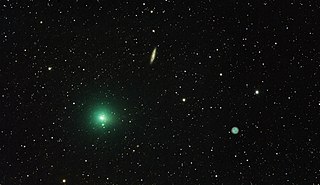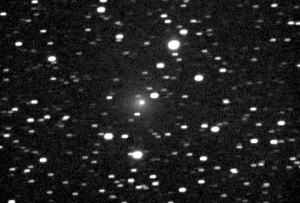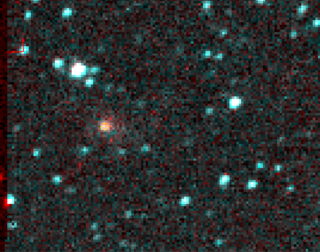Related Research Articles

12P/Pons–Brooks is a periodic comet with an orbital period of 71 years. It fits the classical definition of a Halley-type comet with an orbital period between 20 and 200 years, and is also one of the brightest known periodic comets, reaching an absolute visual magnitude ~5 in its approach to perihelion. Comet Pons-Brooks was discovered at Marseilles Observatory in July 1812 by Jean-Louis Pons, and then later recovered in 1883 by William Robert Brooks.

16P/Brooks, also known as Brooks 2, is a periodic comet discovered by William Robert Brooks on July 7, 1889, but failed to note any motion. He was able to confirm the discovery the next morning, having seen that the comet had moved north. On August 1, 1889, the famous comet hunter Edward Emerson Barnard discovered two fragments of the comet labeled "B" and "C" located 1 and 4.5 arc minutes away. On August 2, he found another four or five, but these were no longer visible the next day. On August 4, he observed two more objects, labeled "D" and "E". "E" disappeared by the next night and "D" was gone by the next week. Around mid-month, "B" grew large and faint, finally disappearing at the beginning of September. "C" managed to survive until mid-November 1889. The apparition ended on January 13, 1891. After the discovery apparition, the comet has always been over two magnitudes fainter.

Comet Giacobini–Zinner is a periodic comet in the Solar System. It was discovered by Michel Giacobini, who observed it in the constellation of Aquarius on December 20, 1900. It was recovered two orbits later by Ernst Zinner, while he was observing variable stars near Beta Scuti on October 23, 1913.

Comet 4P/Faye is a periodic Jupiter-family comet discovered in November 1843 by Hervé Faye at the Royal Observatory in Paris. Its most recent perihelia were on November 15, 2006; May 29, 2014; and September 8, 2021.

10P/Tempel, also known as Tempel 2, is a periodic Jupiter-family comet with a 5 year orbital period. It was discovered on July 4, 1873 by Wilhelm Tempel. The next perihelion passage is 2 August 2026 when the comet will have a solar elongation of 164 degrees at approximately apparent magnitude 8. Closest approach to Earth will be one day later on 3 August 2026 at a distance of 0.414 AU (61.9 million km).
31P/Schwassmann–Wachmann, also known as Schwassmann–Wachmann 2, is a periodic comet in the Solar System. It was discovered on January 17, 1929, at an apparent magnitude of 11. The comet has been seen at every apparition.

41P/Tuttle–Giacobini–Kresák is a periodic comet in the Solar System. The comet nucleus is estimated to be 1.4 kilometers in diameter.

84P/Giclas is a periodic comet in the Solar System. The comet nucleus is estimated to be 1.8 kilometers in diameter. In 1995 precovery images from three nights in September 1931 by Clyde W. Tombaugh were located.
128P/Shoemaker–Holt, also known as Shoemaker-Holt 1, is a periodic comet in the Solar System. The comet passed close to Jupiter in 1982 and was discovered in 1987. The comet was last observed in March 2018.

11P/Tempel–Swift–LINEAR is a periodic Jupiter-family comet in the Solar System.
20D/Westphal was a periodic comet with an orbital period of 61 years. It fits the classical definition of a Halley-type comet. The comet appeared to disintergrate during the 1913 apparition and hasn't been observed since then.

Comet Kopff or 22P/Kopff is a periodic comet in the Solar System. Discovered on August 23, 1906, it was named after August Kopff who discovered the comet. The comet was missed on its November 1912 return, but was recovered on its June 1919 return and has been seen at every apparition since. Close approaches to Jupiter in 1938 and 1943 decreased the perihelion distance and orbital period. 22P/Kopff’s last perihelion passage was 18 March 2022. On 13 July 2028 it will pass 0.353 AU (52.8 million km) from Earth.

23P/Brorsen–Metcalf is a periodic comet with an orbital period of 70 years. It fits the classical definition of a Halley-type comet with. It was first discovered by Theodor Brorsen at the Altona Observatory on July 20, 1847, and again by Kaspar Schweizer (Moscow) on August 11, 1847. It was predicted that it would reappear between 1919 and 1922.

Comet Schaumasse is a periodic comet discovered by Alexandre Schaumasse on 1 December 1911 as 12th magnitude. It next comes to perihelion on 8 January 2026 and should brighten to about magnitude 9.
122P/de Vico is a periodic comet with an orbital period of 74 years. It fits the classical definition of a Halley-type comet with. It was discovered by Francesco de Vico in Rome on February 20, 1846.

43P/Wolf–Harrington is a periodic comet discovered on December 22, 1924, by Max Wolf in Heidelberg, Germany. In 2019 it passed within 0.065 AU of Jupiter, which lifted the perihelion point and increased the orbital period to 9 years.

62P/Tsuchinshan, also known as Tsuchinshan 1, is a periodic comet discovered on 1965 January 1 at Purple Mountain Observatory, Nanking. It will next come to perihelion on 25 December 2023 at around apparent magnitude 8, and will be 0.53 AU (79 million km) from Earth and 110 degrees from the Sun.
75D/Kohoutek is a short-period comet discovered in February 1975, by Luboš Kohoutek. Even on the discovery plate the comet was only apparent magnitude 14. Assuming the comet has not disintegrated the 2020-2021 perihelion passage is only expected to peak around apparent magnitude 20.
72P/Denning–Fujikawa is a periodic comet discovered on 4 October 1881 by William Frederick Denning. The comet was not seen at another apparition until recovered by Shigehisa Fujikawa in 1978. From 29 December 1978 until 17 June 2014, the comet was lost. On 17 June 2014 the comet was recovered by Hidetaka Sato at apparent magnitude 16 when it was 50 degrees from the Sun. The comet came to perihelion in June 2023, and will next come to perihelion in May 2032.

226P/Pigott–LINEAR–Kowalski is a Jupiter family periodic comet with an orbital period of 7.3 years. It was discovered by Edward Pigott on 19 November 1783, but was subsequently lost, until it was recovered on 5 January 2003 by Lincoln Near-Earth Asteroid Research (LINEAR). It will next come to perihelion on 27 December 2023 at about apparent magnitude 15.
References
- 1 2 Ley, Willy (September 1968). "Mission to a Comet". For Your Information. Galaxy Science Fiction. pp. 101–110.
- ↑ "JPL Small-Body Database Browser: 34D/Gale". Jet Propulsion Laboratory. 1938. Retrieved 2010-02-28.

